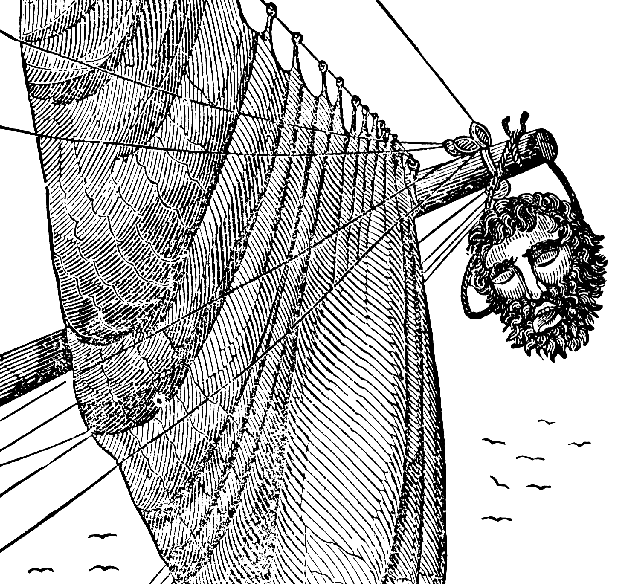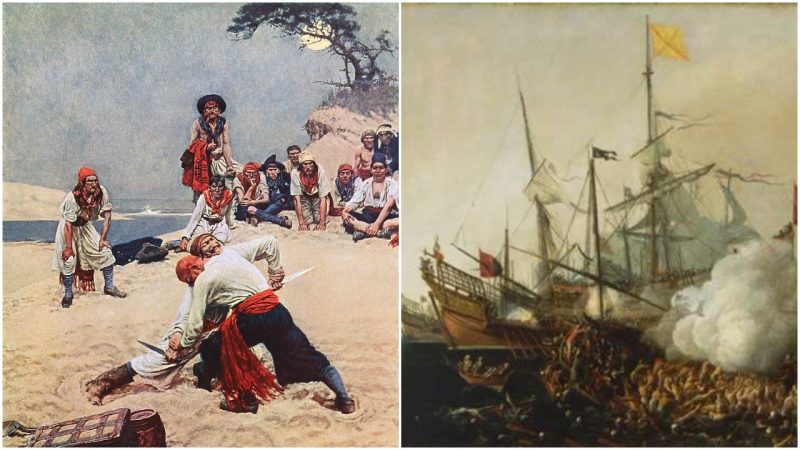Most depictions of pirates in contemporary popular culture are based on the actions of pirates who operated during the golden age of piracy, which lasted from the beginning of the 1650s until the late 1730s. The period between 1650 and 1680 is known as the “buccaneering period”: during that time, English and French pirates on Jamaica and the famous island of Tortuga attacked Spanish colonies and merchant ships in the Caribbean.
The 1690s were known as the “pirate round”; many pirates from the Caribbean and the Americas ventured to the Indian Ocean and the Red Sea to attack Muslim merchants and the supply ships of the East India Company. The final wave of booming piracy, which lasted from 1716 to the late 1730s, was triggered by the end of the War of the Spanish Succession. After the war, many English and American sailors were left unemployed and turned to piracy, usually targeting ships in the Caribbean, the North American eastern seaboard, the Indian Ocean, and the coast of West Africa.
Some of the most famous pirates, including Edward Thatch, known as “Blackbeard,” Bartholomew Roberts known as “Black Bart,” “Black Sam” Bellamy, and John “Calico Jack” Rackham, operated in the final years of the golden age.
Another notorious pirate of that period was Benjamin Hornigold, who started his brief yet prolific pirating career in the winter of 1713.

In the beginning of his career, Hornigold was a low-level looter who organized small raids off the coast of New Providence, the most populous island in the Bahamas. He and his gang used sailing canoes and a small ship to attack merchant vessels. Hornigold progressed quickly: by 1717 he was in command of a 30-gun sailing ship named “Ranger” that was at the time the most heavily armed in the Bahamas. Also, he gathered a gang of around 350 tough men who were all eager to wreak havoc and pillage merchant ships.

Hornigold was the captain and his second-in-command was none other than Edward Thatch, the notorious pirate who later became known as “Blackbeard.” The two of them organized thoroughly planned raids during which they seized several cargo ships and formed a small pirate fleet that became the scourge of the Bahamas. At one point during 1717, the Governor of South Carolina sent a heavily armed ship to find and capture Hornigold. The pirates attacked the ship so fiercely that she ran aground on the island of North Cat Cay and her crew fled for their lives.

Also in 1717, Hornigold and his crew attacked a merchant ship off the coast of Honduras. As terrified merchants begged for their lives, Hornigold’s crew explained that they had gotten drunk the night before and had thrown their hats into the sea, so they had attacked the merchant ship only to steal the hats of her crew. After they took the merchants’ hats, Hornigold and his crew allowed them to continue with their journey. Some historians believe that this curious endeavor was nothing more than Hornigold’s and Thatch’s wish to display their power.
Hornigold never attacked British ships and claimed that he defended British economic policies by attacking the ships of the enemies of the British Empire. However, in November of 1717, Hornigold’s crew decided to overthrow him and attack ships sailing under any flag. Since Thatch was in command of his own ship at the time, he wasn’t around to help Hornigold quell the mutiny. Hornigold was overpowered and forced to flee for his life with a small ship and several of his most loyal men.

Several months later, he sailed to Jamaica and received a pardon for his criminal activities from the then governor of Jamaica named Woodes Rogers. In 1717 and 1718, King George I issued proclamations known as the “King’s Pardons,” which granted an official pardon to all pirates who surrendered to any colonial government under the domain of the British Empire. Governor Rogers granted Hornigold’s request for a pardon, but he also recruited him as a pirate hunter.
Related story from us:Meet the real-life pirates of the Caribbean – not a Jack Sparrow among them
In his final years, the once powerful and feared Hornigold was forced to try and hunt down his former associates, including Blackbeard. Although he sailed around the Bahamas for 18 months, he never managed to catch any of his former allies. During one particularly severe storm, his ship crashed into an uncharted reef between the Bahamas and New Mexico, and Hornigold and his new pirate-hunting crew were never seen again.
